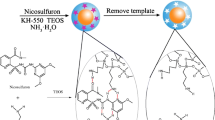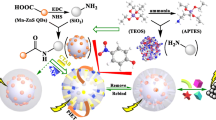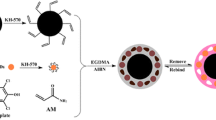Abstract
The surface of poly(methyl methacrylate) nanospheres (PMMA-NSs) was molecularly imprinted with sulfadiazine by a surface imprinting method. Simultaneously, Mn(II)-doped ZnS quantum dots were incorporated into the imprinted PMMA-NSs. The morphology of the fluorescent nanoprobe was characterized by transmission electron microscopy which revealed good spheroidal core-shell structure and a homogeneous distribution of the QDs. Following binding of sulfadiazine, fluorescence (best measured at excitation/emission maxima of 335/592 nm) is increasingly quenched. The detection range is 5–40 μmol·L−1 of sulfadiazine, and the detection limit is 0.24 μmol·L−1. The fluorescence quenching mechanism is discussed, and a photo-induced electron transfer process is shown to account for quenching. The fluorescent probe was applied to the determination of sulfadiazine in spiked tap water with recoveries and RSDs of 96.6–100.2% and 2.7–3.9%, respectively. The detection of sulfadiazine in spiked lake water exhibited the recoveries and RSDs with 99.3–104.8% and 1.8–4.2%, respectively.

Schematic presentation of synthesis of PMMA-Ns, Mn-doped ZnS QDs, MQPs, and the elution diagram of SD from MQPs, and the relative reagents including: sodium dodecyl benzene sulfonate(SDBS), (3-aminopropyl)triethoxysilane(APTES), 3-mercaptopropionic acid (MPA), tetraethylorthosilicate(TEOS)and sulfadiazine(SD), and nanoparticles including: polymer(methyl methacrylate) nanospheres(PMMANs), MIPs@QDs@PMMANs(MQPs) and carbon quantum dots(CQDs).






Similar content being viewed by others
References
Biošić M, Mitrevski M, Babić S (2017) Environmental behavior of sulfadiazine, sulfamethazine, and their metabolites. Environ Sci Pollut Res Int 24:9802–9812
Silvia Diaz-Cruz M, Jesus Garcia-Galan M, Barcelo D (2008) Highly sensitive simultaneous determination of sulfonamide antibiotics and one metabolite in environmental waters by liquid chromatography-quadrupole linear ion trap-mass spectrometry. J Chromatogr A 1193:50–59
Perisa M, Babic S (2014) Simultaneous determination of pharmaceuticals and some of their metabolites in wastewaters by high performance liquid chromatography with tandem mass spectrometry. J Sep Sci 37:1289–1296
Zhao T, Hou XD, **e YN, Wu L, Wu P (2013) Phosphorescent sensing of Cr3+ with protein-functionalized Mn-doped ZnS quantum dots. Analyst 138:6589–6594
Zhang JR, Huang WT, **e WY, Wen T, Luo HQ, Li NB (2012) Highly sensitive, selective, and rapid fluorescence Hg2+ sensor based on DNA duplexes of poly(dT) and graphene oxide. Analyst 137:3300–3305
Chan WC, Nie S (1998) Quantum dot bioconjugates for ultrasensitive nonisotopic detection. Science 281:2016–2018
Pradhan N, Goorskey D, Thessing J, Peng XG (2005) An alternative of CdSe nanocrystal emitters: pure and tunable impurity emissions in ZnSe nanocrystals. J Am Chem Soc 127:17586–17587
Labiadh H, Sellami B, Khazri A, Saidani W, Khemais S (2017) Optical properties and toxicity of undoped and Mn-doped ZnS semiconductor nanoparticles synthesized through the aqueous route. Opt Mater 64:179–186
Suyver JF, Wuister SF, Kelly JJ, Meijerink A (2001) Synthesis and photoluminescence of nanocrystalline ZnS : Mn2+. Nano Lett 1:429–433
Bol AA, Meijerink A (1998) Long-lived Mn2+ emission in nanocrystalline ZnS:Mn2+. Phys Rev B 58:R15997–R16000
Liu X, Zhan XS, Wu FY, Ma LH (2015) Mn(II)-doped ZnS quantum dots modified with Tiopronin for mercury(II) detection. Aust J Chem 68:315–321
Zarejousheghani M, Fiedler P, Moder M, Borsdorf H (2014) Selective mixed-bed solid phase extraction of atrazine herbicide from environmental water samples using molecularly imprinted polymer. Talanta 129:132–138
Yu YJ, Zhang Q, Buscaglia J, Chang CC, Liu Y, Yang ZH, Guo YC, Wang YT, Levon K, Rafailovich M (2016) Quantitative real-time detection of carcinoembryonic antigen (CEA) from pancreatic cyst fluid using 3-D surface molecular imprinting. Analyst 141:4424–4431
Huang DL, Wang RZ, Liu YG, Zeng GM, Lai C, Xu P, Lu BA, Xu JJ, Wang C, Huang C (2015) Application of molecularly imprinted polymers in wastewater treatment: a review. Environ Sci Pollut Res Int 22:963–977
Zaidi SA (2018) Development of molecular imprinted polymers based strategies for the determination of dopamine. Sensors Actuators B Chem 265:488–497
Xu SF, Lu HZ (2016) Mesoporous structured MIPs@CDs fluorescence sensor for highly sensitive detection of TNT. Biosens Bioelectron 85:950–956
Lofgreen JE, Ozin GA (2014) Controlling morphology and porosity to improve performance of molecularly imprinted sol-gel silica. Chem Soc Rev 43:911–933
Huynh TP, Kutner W (2015) Molecularly imprinted polymers as recognition materials for electronic tongues. Biosens Bioelectron 74:856–864
Zhou ZP, Li T, Xu WZ, Huang WH, Wang NW, Yang WM (2017) Synthesis and characterization of fluorescence molecularly imprinted polymers as sensor for highly sensitive detection of dibutyl phthalate from tap water samples. Sensors Actuators B Chem 240:1114–1122
Yan R, Zhang YY, Wang XH, Xu JX, Wang D, Zhang WQ (2012) Synthesis of porous poly(styrene-co-acrylic acid) microspheres through one-step soap-free emulsion polymerization: whys and wherefores. J Colloid Interface Sci 368:220–225
Zhu AP, Shi ZH, Cai AY, Zhao F, Liao TQ (2008) Synthesis of core-shell PMMA-SiO2 nanoparticles with suspension-dispersion-polymerization in an aqueous system and its effect on mechanical properties of PVC composites. Polym Test 27:540–547
Whitby GS, Gross MD, Miller JR, Costanza AJ (1955) Emulsifier-free polymerization in aqueous media. J Polym Sci 16:549–576
Wang HF, He Y, Ji TR, Yan XP (2009) Surface molecular imprinting on Mn-doped ZnS quantum dots for room-temperature phosphorescence Optosensing of pentachlorophenol in water. Anal Chem 81:1615–1621
Acknowledgements
This work was financially supported by the National Natural Science Foundation of China (Grant No. 21677064), Zhenjiang Natural Science Foundation of China (Grant Nos. SH2017046, SH2017048 and SH2017055), Scientific Research Foundation of Jiangsu University (Grant No. 17A008).
Author information
Authors and Affiliations
Corresponding author
Ethics declarations
The author(s) declare that they have no competing interests.
Additional information
Publisher’s note
Springer Nature remains neutral with regard to jurisdictional claims in published maps and institutional affiliations.
Electronic supplementary material
ESM 1
The support materials include: The materials and apparatus; the synthesis of Mn-doped ZnS QDs and PMMA-Ns; The diagrammatic drawing of PMMA-Ns preparation; The XRD spectra of PMMA-ns, Mn-doped ZnS QDs, MQPs and NQPs; The fluorescence intensity of MQPs and NQPs. The fluorescence intensity stability investigation of MQPs; The pH optimization; The structures of SD and similar molecules; The uncertainty research; the absorbability research; The UV-vis of SD and fluorescence intensity of MPQs; The UV-vis of SD, MQPs and mixture of SD and MQPs (DOCX 302 kb)
Rights and permissions
About this article
Cite this article
Gao, Z., Luan, Y., Lu, Y. et al. Fluorometric determination of sulfadiazine by using molecularly imprinted poly(methyl methacrylate) nanobeads doped with manganese(II)-doped ZnS quantum dots. Microchim Acta 186, 625 (2019). https://doi.org/10.1007/s00604-019-3721-1
Received:
Accepted:
Published:
DOI: https://doi.org/10.1007/s00604-019-3721-1




